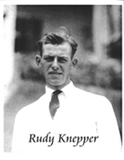RUDY KNEPPER
Sioux City | Inducted 2008 | Category: Amateur Golfer

Rudy Knepper earned a worldwide reputation as an outstanding golfer, going head-to-head with players like Bobby Jones, Francis Ouimet, Chick Evans and George Von Elm.
“I never saw an iron player like him,” said Mike Shearman, the pro at the Sioux City Country Club when Knepper started to make a name for himself. “When he stood up straight with his arms at his sides, his fingers reached to his knees. With such long arms he’d hold the club at the bottom of the leather. He had a very upright swing. There were some who said he had an unorthodox swing. That’s a laugh. Every swing is original.”
Knepper’s first taste of victory came at the 1912 Iowa Amateur, when the 12-year-old caddied for the winner, Bill Sheehan of Des Moines. Two years later, Knepper won the first of three consecutive Sioux City golf titles. Later, he won three straight Iowa Amateurs starting in 1920. He eliminated Art Bartlett of Ottumwa in two of those three victory runs. Bartlett won an unprecedented seven Iowa Amateur crowns. Those Iowa Amateur titles were especially pleasing to H.A. Knepper, Rudy’s father, who was president of the Iowa Golf Association in 1918.
In addition to dominating golf in his home state from 1920 to 1922, Knepper started to have success nationally. He was a runner-up at the 1921 Western Amateur, then won the 1922 Trans-Mississippi. Knepper was also an alternate on the inaugural Walker Cup team in 1922. That competition was held at the National Golf Links of America. To prepare for that, the entire British Walker Cup team entered the U.S. Amateur that year at the Country Club in Brookline, Mass. That’s where famed golf writer O.B. Keeler gave Rudy a nickname – “Lion Tamer.”
Knepper would reach the semifinals, beating British stars W.B. Torrance and Cyril Tolley along the way. Then he beat Ouimet, who outdueled Harry Vardon and Ted Ray to win the 1913 U.S. Open at the Country Club. Ouimet lived in a house across the street from the 17th green. Rudy reached the U.S. Amateur quarterfinals three times and qualified for match play eight times in a 10-year stretch. That championship is where he twice faced Bobby Jones. The first was in 1919, when Knepper was 18 and Jones 17. He took Jones to the 34th hole before losing, 3 and 2. Jones also beat him at the 1924 U.S. Amateur.
Knepper made the Walker Cup again in 1923, but Princeton wouldn’t give him a waiver to play because he’d miss too much class time. That was also the year Knepper lost to Dexter Cummings of Yale, 2 and 1, in the final of the National Intercollegiate Championship.
Knepper also made the cut three times at the U.S. Open, tying for 31st in 1928 at Olympic Fields. He also ran into Jones again in the third round of the 1924 U.S. Amateur. Jones was 3 up after the first 18, but Knepper one-putted five greens in a row at one point to cut the deficit to one hole.
“I hate to play inspired guys,” Jones said. “They can’t seem to miss a putt.”
Jones would go on to win, 6 and 4. Knepper took a step back from competition when he took a job with the bond house of Dillon, Reed & Co. of New York, N.Y. Mr Knepper died on January 16, 1973, at 72 years of age.
Career Highlights
- 1920-22 3-time Iowa Amateur Champion
- 1922 Won the Trans-Mississippi Championship
- 1921 Runner-Up in the Western Amateur
- 1951 Inducted into Des Moines Register Sports Hall of Fame
- Played Collegiate Golf at Chicago, then Princeton
- Was invited to the 1923 Walker Cup but Princeton refused to let him go because it would take away to much time from his studies
- Qualified for the U.S. Amateur numerous times, reaching the semifinals in 1922 and the quarterfinals 3 times
- Defeated Francis Ouimet in 1922 U.S. Amateur, only to lose to U.S. Open Champion Chick Evans in the Semifinals
- Faced Bobby Jones twice, once in the 1919 U.S. Amateur at Oakmont and again in 1924 at Merion
- Appeared in the 1934 U.S. Open at Merion Golf Club

